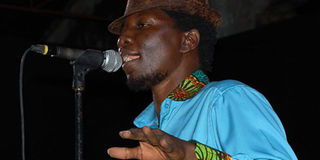Jinja fans enjoy an artful week

Kaz Kasozi of Blue Sugar Cane Band performs during the Doadoa festival at CEPAC in Jinja last week. PHOTOS by Lawrence Ogwal/ Denis Edema
What you need to know:
Doadoa festival. The 4th edition of the Doadoa festival was divided into three segments, workshops, band performances and disc spinning by various DJs, giving revellers a fun-packed time
Art lovers had almost a whole week to have the feel of the 4th Doadoa festival, also referred to as the East African Performing Arts Market.
After the opening event at the National Theatre auditorium on Wednesday last week, the festival headed to Jinja in eastern Uganda.
With more than 200 delegates, among them producers, international festival managers, media personalities, artistes and record label proprietors, the festival created a tangible arts market and networking platform.
“Our vision is defined in creating a performance art market where stakeholders network, facilitate knowledge and business skills that allow artists get more of their content out there,” Faisal Kiwewa, the Doadoa programmes director, said.
Anthony Kimani and Joshua Tujushu of Kenya’s Octave Band said they were privileged to perform in Uganda and it was a dream come true. “We are grateful for the exposure which meets our goal to reign among best bands in Kenya,” Kimani said.
Themes of discussion tackled freedom of artistic expression, challenges artists face in meeting the need for growth, financial benefit and appreciation for their work.
With appreciation, artistes brainstormed on how to make money, giving grass-root bands exposure, capturing audiences and improving the art of performance.
The aesthetic of the Hip-hop industry was broken down in conversation with Shadrack Kuteesa, who under Platinum Entertainment, signed GNL Zamba at the peak of his career and thus sending mainstream his “luga flow” trade into Hip-hop. A comparison with South Africa illuminated how Hip-hop artistes here are struggling that Kuteesa, who, despite advising on how to skyrocket sales on album sales, thinks “Hip-hop has failed to sell in the general market, making it hard to profit. Hip-hop is going down,” he says.
Focus on the search for East African content and how to build a sustainable and creative matrix for East Africa- contributed to plans for Doadoa to tour different urban centres such as Kigali, Bujumbura, Arusha and Dar es Saalam. This has created networks where different artists can be assured of performing spaces. Valued strategy required to have African artistes tour more in Europe tallied with how to meet this demand against challenges of the evasive visas. Confirmative display of one’s work in the media, online presence such as on Youtube and Soundcloud were derived as possible solutions to counter rejection from embassies.
Boosting industry
Boosting East African music on radio and earning music royalties were supplemented by exhibitors such as Uganda Copy Rights Society, talent management brands such as Music Minds, artiste unions such as Batalo East, Matoooke Roots fusion and Fezah, which developed an App to book artistes for gigs.

Members of Annet Nandujja’s The Planets entertain revellers with Kiganda dance
A marriage of performance poetry with music tapped into constructive art forms, but also the contribution of women in the arts met impeccable recommends.
Fred Sebatta nostalgically shared his rise to fame in the 90s, upheavals within an industry he gradually came to love amid attack for redefining traditional Kandongokamu by mixing it with keyboard and guitar sound. His Matendo Promoted Singers Band was as popular as his track Dole Yo Mwana.
The performances
Each of the three nights in Jinja melted down to club music bangers created by Santuri Djs from their recording sessions with the different artistes. They fused live recorded percussion, African instrumental sounds with self-made electrical instrumental jams mashed together to create dance tunes that took revellers through the wee hours of the nights. Even as some played popular club bangers at Queens Palace and Bourbon (hangouts), this sheer genius celebrated a precedent for new dance music.
Yet a conversation with live music from across East Africa yielded impeccable performances at CEPAC (cultural centre), where the market gathered bands from Tanzania, Rwanda, Kenya and Burundi to share a stage, and showcase before stake holders of artiste festivals across the continent and in Europe.
Jemimah Sanyu burned up the stage with her energetic performance, vigorously dancing to every song without a glitch in vocal strength. Her hit song Amaaso Go Googera was ecstatic. Lighting up spray flames, Sanyu and her band of male instrumentalists possessed the stage with musical madness that strung revellers to disco.
Kaz Kasozi and the Blue Sugar Cane Band nailed professionalism with performance, strumming through his eccentrically exotic yet African sound with ease as he tapped and jazzed minimal breakdances and caressed his guitar.
Clad in blue overall and seemingly construction workers, Octave Band impressed with a youthful bridge between Swahili and English. Their urban-Afro fusion gave off rare dance moves and ended with thuds of electronic guitar.
H-art the Band (Kenya) poured their hearts out in song, International Xylophone (Uganda) enriched Busoga’s cultural roots with this polyrhythmic local instrument, while Rwanda’s Strong Voice blazed Rastafarian reggae. Artistes contributed to an interesting range of diversity.
Abeneko from Tanzania blended musical lyrics in Luo, Ngoni, Swahili and English.
Leo Mkanyai and Swahili Blues (Tanzania), Francoise Xavier Ngarambe (Rwanda) and Moutcho (Burundi) Sabar Zibula and Idi Masaba (Uganda).




